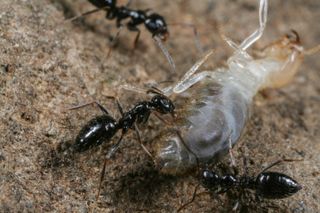
The forests of Ethiopia are teeming with a supercharged ant that is poised to invade the globe, new research suggests.
The infamous ant species, Lepisiota canescens, is demonstrating the behavior needed for supercolony formation and for global invasion — (insect world domination, anyone?), the researchers say.
"The species we found in Ethiopia may have a high potential of becoming a globally invasive species," study author D. Magdalena Sorger, a postdoctoral researcher at the North Carolina Museum of Natural Sciences, said in a statement. "Invasive species often travel with humans, so as tourism and global commerce to this region of Ethiopia continue to increase, so will the likelihood that the ants could hitch a ride, possibly in plant material or even in the luggage of tourists.
"All it takes is one pregnant queen," she added. "That's how fire ants started." [Gallery of Zombie Ants]
Typically, ants form coloniesmade up of one nest and ruled by one queen. But about 20 different ant species — think of them as the Romans or the Incas of the insect world — have their sights set on building an empire. These ants form so-called supercolonies comprising many nests with many queens. Supercolonies can contain billions of individuals that swarm out across the landscape and wipe out their ant neighbors. The Argentine ant, for instance, has a supercolony that spans most of California and is now expanding into Mexico, researchers previously told Live Science, while the biggest supercolony on the planet spans 3,700 miles (6,000 kilometers) across the Mediterranean, according to a 2009 article in the journal Insectes Sociaux.
Sorger's team was surveying ant species in Ethiopia when they found that L. canescens was showing some of the hallmarks of supercolony formation — namely, an ability to expand without any constraints. A genetic analysis revealed that the different colonies contained genetically diverse members and that the species is native to the region.

In Ethiopia, many of the churches are surrounded by forests in an otherwise forbidding landscape. The ants seemed to have a preference for these forests, the researchers said. In addition, L. canescens seemed to have an uncanny ability to cross from its preferred forest habitat to nearby farmlands, roads and buildings, the researchers reported in the current issue of the journal Insectes Sociaux.
Sign up for the Live Science daily newsletter now
Get the world’s most fascinating discoveries delivered straight to your inbox.
The largest colony was still relatively modest in absolute terms, crossing an expanse of roughly 24 miles (38 km) in length, but this population is actually the largest supercolony documented in an ant species living in its native habitat, the researchers noted. Even stranger, its rapidly expanding population and aggressive expansionist behavior are more typical of invasive species, the researchers wrote in the journal article.
The findings suggest the possibility that these ants could become global hitchhikers that colonize other regions, the researchers wrote.
"It is good to have a record of what this species does in its native habitat," Sorger said. "Rarely do we know anything about the biology of a species before it becomes invasive."
Original article on Live Science.

Tia is the managing editor and was previously a senior writer for Live Science. Her work has appeared in Scientific American, Wired.com and other outlets. She holds a master's degree in bioengineering from the University of Washington, a graduate certificate in science writing from UC Santa Cruz and a bachelor's degree in mechanical engineering from the University of Texas at Austin. Tia was part of a team at the Milwaukee Journal Sentinel that published the Empty Cradles series on preterm births, which won multiple awards, including the 2012 Casey Medal for Meritorious Journalism.